2010 American Photo Editors’ Choice
Of the hundreds of products released this year, these are the ones that matter most, the true innovations in the field.
We may earn revenue from the products available on this page and participate in affiliate programs. Learn more ›
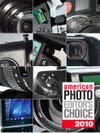
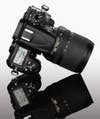
Continuous autofocus finally comes to DSLR video, allowing photographers to shoot moving subjects without the need to follow-focus manually. Nikon started the video-DSLR revolution with its trendsetting 12.3-mega-pixel D90, but it and all the DSLRs that followed suffer from the same flaw: their inability to continuously autofocus when you’re shooting video. This has limited DSLR video shooting to photographers willing to manually adjust focus—particularly difficult with a moving subject and when the photographer wants to get closer to or farther from a subject. Now comes the 16.2-megapixel Nikon D7000, which can follow-focus automatically in its HD video mode—giving photojournalists, sports photographers and others much more shooting freedom. The new DSLR accomplishes this feat with full-time contrast-detection autofocus similar to that in ILC cameras. Called AF-F, this Nikon-exclusive system can be used in four live-view/ movie AF modes, and it works best with a fast-aperture ultrasonic AF-S lens. What’s more, the D7000’s video is Full-HD 1080p at 24fps, in AVCHD format, with manual audio levels and full exposure control. Other serious features include 100-percent viewfinder coverage, ISO 25,600 maximum sensitivity, dual SD/SDHC/SDXC card slots, 6fps capture and a weather-sealed magnesium-alloy body. _About $1,200; nikonusa.com__.___ Jon Whittle/Michael Kraus
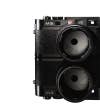
The digital rangefinder returns to its full-frame roots with a 35mm-sized image sensor optimized for Leica’s extraordinary lenses. Having pioneered the 35mm still camera nearly a century ago, Leica comes full circle with the first digital rangefinder to incorporate a 35mm-sized image sensor—a design its engineers had deemed impossible because of the steep, light-sapping angle at which the outer rays from its short back-focus lenses would strike the sensor’s surface. But the M9’s 18-megapixel CCD brilliantly proves otherwise with an innovative light-balancing microlens overlay that works with image processing that automatically adjusts to suit the optical characteristics of the lens in use. Because there is no anti-aliasing filter in front of the image sensor, the camera actually equals or betters the resolution of full-frame DSLRs in the 21-to 25-megapixel range. As you’d expect, the M9’s magnesium and brass body feels both bulletproof and supremely comfortable. Shooting with it is direct, instinctive and discreet—manual focus notwithstanding. But it’s still digital, saving Adobe DNG or JPEG files to an SD card. Above all, the M9 excels at pure image quality, thanks to Leica’s incomparable M-series optics._About $7,000; en.leica-camera.com__.___ Jon Whittle/Michael Kraus

This amazing, affordable digital stereo camera records both stills and movies in totally compelling 3-D. And you can watch them without special glasses. In a year that saw the first 3-D Hollywood blockbuster and the mainstreaming of 3-D home entertainment, it’s fitting that ordinary consumers can now create their own 3-D digital content with this breakthrough system from Fujifilm. The FinePix W3, which succeeds the W1 camera originally marketed in Japan, uses twin 10.17-megapixel CCD sensors to capture stereo MPO stills and stereo AVI videos at 720p HD resolution. Offering entry-level, mostly automated features, the comfortably contoured W3 is slightly wider and thicker than a conventional point-and-shoot. Sliding open its front cover reveals identical lenses (each with 3X internal, optical zooming) spaced three inches apart, which creates the parallax disparity needed for stereo imaging. In back, the W3 features a spectacular 3.5-inch, 1.15-million-dot widescreen LCD with a lenticular-style overlay that eliminates the need for special glasses to see in 3-D. The image pairs are ghosted at first, but focusing aligns them for comfortable viewing. We achieved the best results by including both fore- ground and background elements while keeping our main subject about four to six feet away. When it works right, the depth effect is almost hallucinatory, and 3-D videos taken with the camera are truly immersive. That’s especially so on a bigger screen—any HDMI-connected 3-D HDTV (though you’ll need spe- cial glasses). FinePix W3 shooters can order 3-D prints from SeeHere.com. _About $500; fujifilmusa.com__.___ Jon Whittle/Michael Kraus
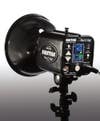
This portable pro flash unit offers uniquely short bursts and ultrafast recycling, enabling rapid-fire, action-stopping photography at an unbeatable price. High-output AC-powered strobes, useful for many assignments, are less suited to fast-paced subjects because their flash duration is too long to consistently freeze motion and their recycle time is often insufficiently fast for rapid-fire frames. In contrast, the affordable yet sophisticated Einstein 640 Monolight is uniquely capable of super-short flash durations. It accomplishes this with special circuits that quench its flash tube very quickly—a technology common to hotshoe flashes but not studio strobes. This is especially valuable when you reduce recycle time by lowering out- put to keep pace with the framing rate of a high-speed DSLR. Set to Action mode, the Einstein delivers bursts as short as 1/13,500 second, syncing with a camera shooting up to 10fps. For portraits and other critical work, you switch to Constant Color mode, which maintains 5,600 degrees Kelvin (+/- 50 degrees) at all power levels. Other specs are equally impressive, among them a 250-watt modeling light with brightness proportional to flash output and a microSD slot for upgrading firmware. _About $500; paulcbuff.com__.___ Jon Whittle/Michael Kraus
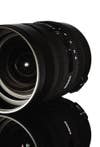
This ultrawide zoom delivers the widest rectilinear coverage available for APS-C-format DSLRs, not to mention superior optical quality and great handling. Sigma’s current 12-24mm f/4.5-5.6 is the widest non-fisheye you can get for a full-frame DSLR. The all-new 8-16mm DC is functionally equivalent to it but designed specifically for APS-C-format cameras—offering the same mind- blowing maximum angle of view and the surreal, exaggerated perspective that comes from shooting so close. At 3.0×4.2 inches and 19.6 ounces, it’s slightly smaller and lighter than Sigma’s full-frame version, and it focuses 1.6 inches closer, to 9.4 inches. The lens’s Hyper Sonic Motor AF is fast and silent. The new lens’s exotic design consists of 15 elements in 11 groups, including four fluorite-like low-dispersion elements plus one hybrid aspherical and two molded glass elements. The result is superior sharpness compared with others in this class (though no competitor is as wide), with mild chromatic aberration only at longer zoom settings. We found vignetting moderate except at 8mm with the lens wide open. Barrel distortion is apparent at the widest setting and pin- cushion at the longest, but both are correctable in software. Available in Nikon, Canon, Sony, Sigma and Pentax mounts. _About $700; sigmaphoto.com__.___ Jon Whittle/Michael Kraus

The world’s tiniest ILC and the first interchangeable-lens consumer camcorder have a lot in common—including optics. As the world’s smallest, lightest interchangeable-lens compact, Sony’s unorthodox NEX-5 stakes different turf than its Micro Four Thirds competitors. In essence, it’s a super-stylish point-and-shoot that takes interchangeable lenses (Sony E-type) rather than a diminutive DSLR substitute. Yet its 14.2-megapixel image sensor is bigger than the chip in Micro Four Thirds models—the same APS-C size, in fact, as those in most DSLRs. The NEX-5’s other assets are estimable, too. They include a rugged magnesium-alloy body, sensitive 14.2-megapixel APS sensor and 921,000-dot, 3-inch tilt-screen. It also has super-swift AF and LCD response, 7fps shooting speed, HDR and Sweep Panorama mode—and Full-HD 60i AVCHD video, a rarity in this class. It even shoots in RAW format. Maybe more unusual, though, is the NEX-5’s fraternal twin, a camcorder called the NEX-VG10. It incorporates the same sensor, lens mount and LCD screen as the NEX-5, not to mention most other features, including still capture. That’s huge news, because it’s the first of its kind with an APS-C-sized chip and silent-focusing inter- changeable optics, thereby offering filmlike shallow focus, low-light prowess and better video handling than any DSLR. And it costs a fraction of any professional equivalent. _About $650 (NEX-5, with 16mm f/2.8); $2,000 (NEX-VG10, with stabilized 18-200mm); sony.com__.___ Jon Whittle/Michael Kraus
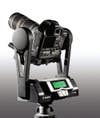
This NASA-derived robotic camera mount finally accepts large DSLRs and lenses, advancing multi-frame gigapixel imaging to a new level. Once only a fiction in the movies, the concept of a digital image with practically infinite detail has become a reality, courtesy of Giga-Pan motorized camera mounts. Derived from NASA imaging technology, these systems precisely automate the process of shooting dozens or even hundreds of separate frames that, when stitched together in software, create gigapixel-size (1000-megapixel-plus) images. The first models supported only smaller, less advanced cameras, but the new GigaPan EPIC Pro holds 10 pounds, enough for full-frame 25-megapixel DSLRs and bigger lenses, significantly extending its microcosmic reach. The battery-powered gimbaled mount has a simple LCD menu and four-way motion controller, which you use first to measure your camera’s vertical angle of view, then to establish the top left and bottom right corners of your planned image. Press “OK” and the GigaPan goes to work, tripping the shutter via electronic cable while repositioning itself for each new frame. The number of shots depends on the angle covered, focal length, memory card size, computer power—and your patience while GigaPan’s software renders these gargantuan files. _About $900; gigapansystems.com__.___ Jon Whittle/Michael Kraus
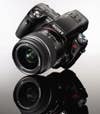
A revolutionary translucent mirror design finally brings the speed of DSLR autofocus to the small size and optical advantages of an electronic-viewfinder camera. Though it physically resembles other Alpha APS-C-format DSLRs, the SLT A55 is actually a live-view camera with a large, exceptionally clear 1.44-million pixel electronic viewfinder instead of a conventional pentaprism and focusing screen. The SLT (Single Lens Translucent) design replaces the DSLR’s instant-return reflex mirror with a fixed semi-silvered mirror, which allows most of the light from its lens to pass through to its new, high-sensitivity 16.2-megapixel CMOS sensor. The rest is diverted to its 15-point autofocus module, which uses a DSLR-type phase-shift detection system that’s superior to the contrast-detection AF in other live-view cameras. This ingenious system significantly reduces the A55’s size and weight compared with conventional Alpha models. And with no interruption in autofocus, it can continuously track moving subjects during exposure. Plus it can shoot at an astounding 10fps—until now possible only with pricey pro models. The A55 is also the first Alpha that records video (Full HD). About $750; _sony.com___ Jon Whittle/Michael Kraus

Designed like a consumer DSLR, the 645D drops medium-format digital to less than half the price of its competitors— yet still offers awesome resolution and a huge existing lens selection. Pentax’s first medium-format digital camera is a bombshell, delivering 40-megapixel image quality for radically less money than comparable medium-format systems. How does it do this? By borrowing core technologies from the APS-C-format Pentax K-7 DSLR. In fact, it will seem instantly familiar to any Pentax DSLR owner. That said, the 645D’s gigantic 44×33-millimeter Kodak CCD boasts two-thirds more pixels than a full-frame 24-megapixel DSLR and produces 23×30-inch native image size at 240dpi, ideal for big prints. The body itself offers superb balance and ergonomics, a light but tough magnesium-steel alloy frame with extensive weather sealing, and automatic sensor-dust cleaning, a first in a medium-format digital camera. It also features built-in automatic correction for a given Pentax 645 lens’s optical characteristics. It shoots in RAW (Pentax PEF or Adobe DNG) or JPEG format and saves to dual SD cards. _Under $10,000 (limited availability); pentax.jp/English__.___ Jon Whittle/Michael Kraus
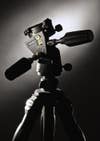
The world’s first five-way tripod panhead combines speed, flexibility and precision with unique features for panoramic and 3-D photography. This well-made, cleverly designed product is the first of its kind to combine the best attributes of a conventional panhead (precise and repeatable framing) with those of a ballhead (speed, simplicity and a wide range of movement). In fact, the “quintaxial” Induro PHQ offers precision adjustments in five separate directions. Its range of movement actually exceeds that of some very expensive geared heads, but it’s a lot faster to operate. The PHQ’s two rotating handles control vertical and horizontal tilt (+90/-15 and +90/-45 degrees), and conveniently fold for easier transport. Both its base plate (attached to the tripod) and its top plate (attached to the camera) independently rotate 360 degrees. This allows leveled panning at any tripod angle, eliminating distortion in stitched panoramas. It also means you can level the head on uneven terrain without endless tripod-leg adjustment. Finally, the bidirectional Arca-Swiss- compatible quick release conveniently slides up to 20mm left and right. This is useful for weight balancing and creating stereo pairs for 3-D photography. The same ability allows precise alignment of image pairs taken with a perspective-control lens for stitching purposes. _Available in two versions: PHQ1 (to 25 pounds; $315) and PHQ3 (35 pounds; $395); indurogear.com__.___ Jon Whittle/Michael Kraus
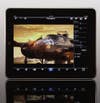
This one-of-a-kind touchscreen tablet is the classiest, most intuitive digital photo album you can get—and it’s ideal for sharing images with a client. Apple’s much-hyped iPad is the first entry in a transformative new category of personal, Web-enabled multimedia devices. The sheer size and stunning detail of its 9.7-inch LED- backlit display practically clinches its appeal for photographers. It’s also a wonderfully compact tool for offloading, managing, viewing and sharing photos on the road (though its internal memory is somewhat limited) as well as an elegant way for pro photographers to bring pictures or videos to a meeting. With 1024×768 resolution, the iPad’s screen is also great for playing HD movies. And its incredibly responsive Multi-Touch interface lets you show off your images with intuitive finger gestures. At only a half-inch thick, this Apple is exquisitely crafted, in brushed aluminum and tempered glass. It’s not a full-function computer, but it does include Wi-Fi and optional 3G, add-on connectors for SD cards and digital cameras, a virtual QWERTY keypad and touch-enabled software such as Safari, iWork, iBook and YouTube. Photos, its elegant viewer and organizer, sorts pictures using Events, Faces and Places metadata and plays slideshows with music from iTunes. You can now download more than 400 third-party iPad-compatible photo apps. These include filters and effects, online photo services, editing tools and Eye-Fi card wireless file transfer straight from your camera. _Available with 16GB, 32GB or 64GB of flash memory; about $500 to $830; apple.com__.___ Jon Whittle/Michael Kraus
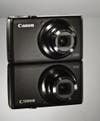
The world’s smallest RAW- and HD-video-capable “professional” compact features a unique click-stopped lens ring for customizable control. Compact cameras good enough for serious photography are rare—and this stylish gem is the smallest and lightest one yet. The sturdy, metal-clad S95 is just half the size and weight of Canon’s top compact, the PowerShot G12. Yet it incorporates that model’s 1/1.7-inch CCD image sensor, which is among the biggest in its class. Because the S95 only has to squeeze 10 megapixels of resolution into that chip, it delivers remarkable quality at higher ISOs, aided by advanced DIGIC 4 image processing. What’s more, like the G12, the S95 can shoot in RAW mode, recording more tonal and color data and permitting much greater control in post-processing. Though it sheds the G12’s vari-angle LCD, hotshoe and optical viewfinder, the S95 is actually better in some ways. It has a bigger screen (a 3-inch, 461,000-dot LCD), a faster 28-105mm (equivalent) zoom and 24fps, 720p HD video with stereo sound. But the S95’s unique programmable Control Ring is its true innovation. Surrounding the lens and click-stopped like a traditional aperture ring, it can be assigned any of nine separate functions, including ISO, exposure compensation, white balance, manual focus and aspect ratio. _About $400 (with Canon’s professional RAW software); usa.canon.com__.___ Jon Whittle/Michael Kraus